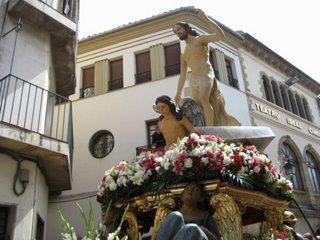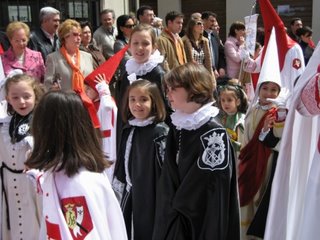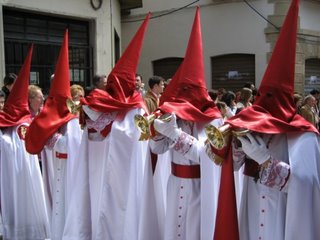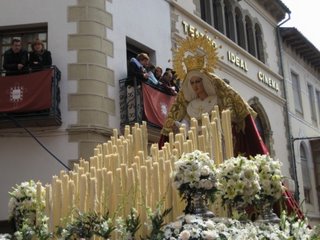Perhaps one of the most interesting things to see in Spain is something that you can´t see anywhere else in the world. I am, of course, talking about the festivities of Semana Santa, or Holy Week. The week spanning Palm Sunday and Easter Sunday is filled with processions and parties the likes of which you have never seen. Never, that is, unless you have been in Spain for Holy Week.

For the uninitiated, the processions can be a little disconcerting. Especially for those of us from the good 'ol US of A, the costumes worn by the procession participants have some negative associations with the KKK. With that in mind, here´s a little background info on the traditional procession garb:
Before/during the Spanish Inquisition the robes and hoods were the mark of pure Catholicism. The pointed hoods with masks were to show that all "pure," pious Catholics held equal status in the eyes of God. The hoods are pointed because they elevate a person toward heaven. During the inquisition the Catholic church made heretics wear the robes and hoods as a symbol that they were lacking this pure Catholicism and were being crucified (or burned) in order to purify their souls.
The different colors of the robes signify specific parishes/churches. Each church has their own Jesus, corresponding to a specific day/event during Semana Santa, their own Virgin Mary, and a Patron Saint. The colors of each of the robes signify which Jesus/Virgin Mary/Patron Saint combination is "theirs." The robe colors follow a trajectory from light--starting on Palm Sunday--to dark. The wear the darkest colors on Good Friday: they are robed from head to toe in black with sashes of dark green, dark blue, and purple to signify the crucifixion and death of Jesus. The spectrum returns to light colors on Saturday and they wear the lightest colors (usually white robes with red or green sashes) on Sunday to signify the joy of the resurrection of Jesus.
Each church in Úbeda is responsible for organizing the procession that corresponds with "their" Jesus. The church who has "Jesus crucified" plans the procession for Good Friday. The church with "Jesus Resurrected" is responsible for the Easter Procession, etc. On Easter, the procession is led by the church that has "Jesus Resurrected" followed by representations of the ascent of Jesus to heaven, the Virgin Mary, and all of the other churches.
[Hat tip to my professor Alice Nelson, and also to the nice old man who runs the Super Regalo 99 here in Úbeda, for the information.]




Read more!







































